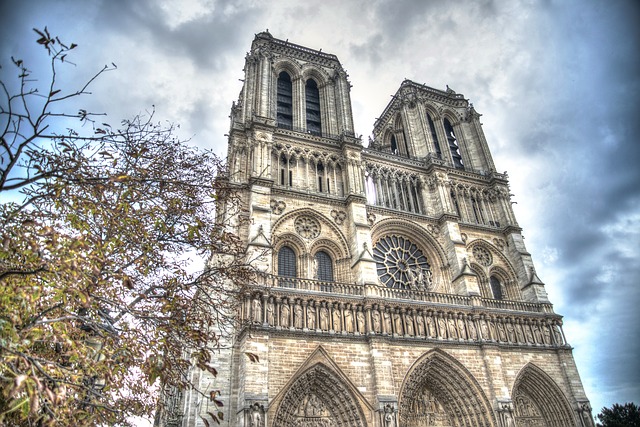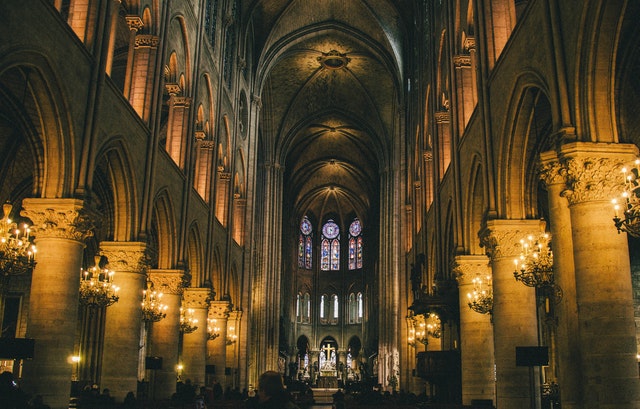Architecture of Notre Dame: The symbol of France
Notre Dame, the most famous among the Gothic Cathedrals sits in the heart of France, Paris. It is famous for its size, antiquity, and distinctive architectural features. The architecture of Notre Dame is surely worth admiration. Let us take a brief dive into the Cathedral of Notre Dame Architecture.
Notre Dame de Paris is the local name of this majestic cathedral, which in French means “Our Lady of Paris”.
This landmark of Paris, known for its architectural beauty, began to take shape in 1160. Surprisingly, it took over 182 years to complete the architecture of Notre Dame. It was titled the tallest structure in Paris until the construction of The Eiffel Tower in 1889.
This cathedral came into shape as a center to celebrate the culture of France. Therefore, the architecture of Notre Dame had to be monumental.
Cathedral of Notre Dame Architecture: Exploring the Jewel

The architecture of Notre Dame stands to be one of the finest examples of richness. The building is famous for marvelous Gothic sculptures and its stained glass art. One simply cannot stop gazing at the beauty and the minute details of this masterpiece.
Noteworthy Points:
- Notre Dame Cathedral, known as the largest religious building in the world. It is 130 meters (425 feet) long, 48 meters (157 feet) wide, and 35 meters (114 feet) high. It reaches up to 69 meters, (226 feet) including the tower.
- The building consists of a choir and apse, a short transept, and a nave, surrounded by double aisles and square chapels.
- Two distinctive features of the architecture of Notre Dame are its flying buttresses and gargoyles.
- The roof of the Cathedral is in wood, which is quite surprising for such a huge structure. Also, the timber frame consists of wood from 1300 trees, each beam made out of one tree. The roof structure is also referred to as “The Forest” due to its material and massive dimensions.
- The Cathedral of Notre Dame Architecture also follows the “Golden Ratio“, which brings the building to perfection visually. The overall building, as well as the decorative details, everything follows this magical ratio.
- Two tall Gothic towers frame the architecture of Notre Dame. Between these two towers, a spire stands which rises from the transept.
- Between the two towers, there is a lead roof water reservoir, that provides water for fire fighting.

The mind-blowing elements of the Cathedral of Notre Dame Architecture, mainly long halls, and vaulted ceilings offer humanity and divinity. Soft light enters the interiors via the complex windows. The beauty of the Rose Window of the Cathedral is one of the major elements of attraction.
The Architecture of Notre Dame Towers:
The two famous bell towers of the building increase the Cathedral’s height up to 69 meters (226 feet). Located on the North and South side, the building’s towers are very impressive. To enjoy the incredible view of the whole city from these towers, you have to climb 400 stairs. The top of the towers is rich, with statues of scary carrion birds and intimidating demons. The South tower also accommodates the large bell of 13 tonnes.
The Facade of Notre Dame:

The Cathedral’s iconic facade depicts the exotic touch of craftsmanship and stone sculptures. The facade completely enhances the architecture of Notre Dame, which is beyond comparison.
- There are three doorways on the western facade, leading to the inside of the Cathedral. The main entrance is sculpted with saints and sacred scenes. The three portals have their own significance and the exterior walls are full of statues.
- The famous two towers of the Cathedral seem to be identical. However, they are actually not! One tower is a bit bigger than the other.
- Marvelous “Rose window” holds the statues of God’s first human creatures, ‘Adam and Eve’. The diameter of the window is whopping 10 meters (32.8 feet).
- ‘Grande Galerie’ serves as the connection between the two towers. It showcases images of violent demons and birds.
- Famous Gothic elements in the Cathedral of Notre Dame Architecture, gargoyles and chimeras made up of stone are not as old as the Cathedral. They were added in the 19th Century during the restoration of the architecture of Notre Dame.

The Spire of Notre Dame:
The spire of the Notre Dame in Paris is rich with sculptures. It is surrounded by copper statues of the twelve Apostles, each with a group of three.
The original spire was constructed along with the building in the 13th century. However, due to wind pressure, it got bent over the centuries and had to be completely removed in 1786.
The spire was again restored during the 19th-century restoration of the Cathedral of Notre Dame Architecture. However, due to a huge fire in 2019, it got destroyed once again.
The restoration of the Spire will be its third time since the construction of the Cathedral.
Point Zero:

Point Zelo, situated in front of the Cathedral usually gets ignored due to the majestic architecture of Notre Dame. However, it is a very important and minute detail in front of the church. Point Zero is the official reference point, representing Paris.
It is a circular tiny plate, inscribed in square flooring, engraved with a compass. The compass indicates all the distances to and from the city of Paris.
The interiors of Cathedral:

The interior of the Cathedral is as astonishing as the exterior facade. Several prominent decorative elements boost the ambiance of the Cathedral interiors.
- The stained glass windows, mainly the three Rose windows, are very beautiful and symbolize the “Holy Trinity” and give a sense of divine presence in the church.
- One of the most religious artifacts, ‘The Crown of Thorns’ also rests inside the Cathedral.
- Notre Dame also has some priceless treasures which include the Holy Crown worn by Christ, a piece of the Cross, and a nail.
- The interior of the tower has a total of 10 bells.
- The grand organ is the imposing instrument, placed 16 meters (52.5 feet) above the hall. It holds 8000 pipes, five keyboards at multiple levels, pedals, and 109 stops. The instrument catches your attention as you move across the hall. The pipe organ of Notre Dame is the most famous in the entire world.

Effects of Wars on Cathedral of Notre Dame:
The Cathedral was popular as “a symbol of the power and aggression of Church and monarchy” during the French Revolution. The revolution destroyed various prominent sculptures and statues of the Cathedral.
The iconic Rose Windows of the Cathedral were removed during World War 2 due to the fear of damage. These windows were installed back when World War ended.
The recent fire:

A fire broke out in the Cathedral on April 15, 2019. It destroyed the iconic spire and a major part of the roof. The most important treasures of the Cathedral like the Crown of Thrones, religious artworks, the bell tower and the rose windows remained intact even after the fire. The damage incurred due to the fire is still under restoration.
Restoration of the Cathedral of Notre Dame Architecture:
The building went through a restoration process in the 19th century. Various elements also had to be added which got destroyed during the wars. The Cathedral also got new bells.
The Central Spire of the Cathedral also underwent restoration during this period. The old spire was removed completely due to instability.
The Cathedral has suffered many damages throughout the centuries. However, the architecture of Notre Dame still remains one the most marvelous in the entire world. It is embellished with endless beautiful elements throughout the whole structure. Moreover, one remains amazed in the entire journey of the Cathedral.

